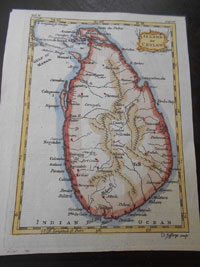Learning about the past from the map makers of history
I do not know if the French geographer, Jacques Nicolas Bellin, who died 300 years ago – on March 31, 1772 – ever visited Sri Lanka. But his printed maps and copper engraved prints depicting the island and its scenes, are a fascinating record of the past.
Bellin’s map of Ceylon was originally published in 1764 and is now a rare collector’s item. He also published in 1754, a plan of Galle Fort and a sketch of it as seen from the sea.

1756 Ceylon map by Jefferys
Bellin’s copper engraved map of the Maldives, from the book Histoire General des Voyages by Prevost, published in 1750, sold recently at a local auction for Rs. 110,000. Its accuracy long before cyber mapping was invented, is astonishing. Male’ is captioned as the capital or “Isle of the King” and all the atolls correctly shown and named.
It was not only maps that Bellin produced. He included some amazing engravings in a book published in 1754 of creatures of Ceylon. One shows animals, including a mongoose, with long tails; another depicts birds, notably a pair of long-tailed “Oiseaux de Paradis.” A third engraving features ferocious-looking insects and animals. The detail of each engraving on copper plate, from which the illustrations were printed over two centuries ago, is remarkable. Untouched by later colouring, the creatures are life-like.
Jacques Nicolas Bellin was born in Paris in 1703. His talent as a map maker and draughtsman was evident from an early age. When he was only 18, he was appointed as Hydrographer (Chief Cartographer) to the French Navy. Twenty years later he became official hydrographer of the French king. He was a member of the French group called Les Philosophes and of the Royal Society of London.
If he never visited all the countries he mapped so successfully, nor saw the creatures he drew so vividly, how did he produce such detailed work? The vast majority of old maps printed between 1550 and 1825 were produced by engraving. In this process, an image is first incised into a copper plate using a sharp tool. The plate is inked and then wiped, leaving ink only in the incised areas. Bellin’s skill was in transposing with studied finesse the drawings of mariners who had mapped countries or of explorers who had encountered exotic creatures. He gave credit where it was due, but relished the praise for his work.
He is famed not just for his maps and sketches of Asia but also for his maps of French interest, such as those of French territories in North America and Canada. He died at Versailles when he was 69, having become one of the most important cartographers of the 18th Century.
His English counterpart was Thomas Jeffreys (1719-1771), a celebrated geographer and publisher who dominated English cartography in the mid-1700s. His attractive map of the island of Ceylon was published in the 1756 edition of A Compendium of Authentic and Entertaining Voyages.
This map probably owes a lot to Bellin’s map published two years before, as it features several places with French spelling. However, Adam’s Peak is clearly shown as Adam’s Rock and I was happy to see the town where I live, Bentota, is there, although named as Bentol (Bentot).
Collecting antique maps and prints of Sri Lanka is an addictive hobby but a rewarding one for what they reveal about Sri Lanka before modern printing and Google maps.
For instance, on the Jeffrey’s map, there is an area near Galle called Red Bay and another place inland from Colombo that is unidentifiable today, Fort Corvite, which proves we can learn a lot about the past from the map makers of history.
An auction of paintings, antique prints and maps will be held at the auction facility of Schokman & Samerawickreme, Colombo, on Sunday, April 3.
Searching for an ideal partner? Find your soul mate on Hitad.lk, Sri Lanka's favourite marriage proposals page. With Hitad.lk matrimonial advertisements you have access to thousands of ads from potential suitors who are looking for someone just like you.


